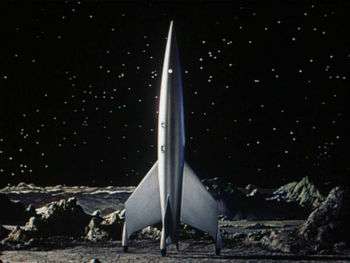Destination Moon

Seven years before Sputnik, and nineteen before the Apollo 11 landing, this production by George Pál was the first major science-fiction film produced in the United States that dealt seriously with the prospect, problems, and technology of space travel.
Frustrated by his failure (implied to be the result of sabotage) to successfully launch an artificial satellite, a scientist approaches US private industry with a grander project: to build a nuclear-powered rocket to land upon the Moon. Sinister forces try to stop the launch via public protest and legal action, and the rocket has to take off ahead of schedule to avoid a court order. After a spacewalk and the obligatory mid-mission crisis, the rocketship lands on the Moon but uses too much reaction mass doing so. Even after stripping their vessel of every spare component, the only way they can get back to Earth is if someone stays behind...
Not to be confused with the Tintin story which also depicts a version of the first moon landing with a strangely similar prescient scenario.
- Campbellian Hero: Good 'ole American industry, determination and ingenuity conquer all obstacles.
- Cold Equation
- Color Coded for Your Convenience: Invoked with the spacesuits.
- Deus Ex Nukina: None of this would be possible without the atomic drive. And the motive for landing on the moon isn't national pride, commercial interest, or even For Science!!, but purely and simply to stop those Dirty Communists from setting up a lunar missile base from which they can control the Earth!
- Dirty Communists: Well, the unseen agents of a foreign power, but we all know who they are. They try to stop the project through sabotage, organising public protests, and legal action.
- Dueling Movies: Rocketship X-M stole this movie's thunder by rushing to the screens quicker than its more expensively produced rival. Interestingly the movies have diametrically opposite messages -- Destination Moon is pro-nuclear, while Rocketship X-M has an anti-nuclear message (the crew lands on a Mars devastated by atomic war).
- Exposition: By Woody Woodpecker, no less. Joe Sweeney also serves as a Mr Average the scientists have to explain things to.
- Hard Work Montage: Several of these.
- Heroic Sacrifice: While the three main characters are arguing over who's going to stay behind, Joe Sweeney quietly slips out the airlock and laconically tells the others to return to Earth without him. Of course as the comic relief never gets killed the others figure out a way to save everyone.
- Hollywood Science: Averted as George Pal went to great lengths to make everything accurate, with advice from Robert Heinlein and space artist Chesley Bonestell.
- Improvised Microgravity Maneuvering: An oxygen tank is used to rescue someone adrift in space.
- In Space Everyone Can See Your Face: Averted with no lights in the helmets, though the faceplates are clear. Instead coloured spacesuits are used to tell everyone apart.
- Interplanetary Voyage
- Mundane Dogmatic
- No OSHA Compliance: Check out that ladder on the Luna. When was the last time you climbed a ladder that was eight stories tall?
- One-Scene Wonder: The scene where Woody Woodpecker appears in a brief animated segment explaining rocket propulsion.
- Plucky Comic Relief: When one of the original crew falls ill, Flight Engineer Joe Sweeney is reluctantly convinced to come along as radio operator. His general lack of enthusiasm for the project is a Running Gag, which is later subverted (see Heroic Sacrifice).
- Retro Rocket: Along with Chesley Bonestell's artwork in the illustrated book The Conquest of Space, this movie could well be the Trope Codifier.
- Robert A. Heinlein contributed significantly to the script (which draws on his works Rocketship Galileo and the later-published The Man Who Sold the Moon) and served as a technical adviser.
- Science Marches On: The moon surface cracked from the sun's heat turned out to be inaccurate, as were the craggy lunar mountains.
- Sound in Space: Mostly averted (there's a hissing oxygen cylinder in the man adrift scene) however the trope is lampshaded, and grand orchestral music is used to cover the lack of ambient noise.
- Space Clothes: Each spacesuit is a different colour so the audience can tell who's who. The suits were recycled for later (and cheaper) sci-fi including Flight to Mars (1951), the TV series Space Patrol, and the spoof Amazon Women on the Moon.
- Tim Taylor Technology: What does a Campbellian Hero do when facing public concern that an atomic rocket will explode on take-off, spreading radioactive debris over hundreds of miles? Take off, of course!
"How do you test a machine of this type? It either works or it doesn't."
- What Could Have Been: This reviewer put it best:
Destination Moon created the great SF boom of the 1950s. It offered a single, wild leap of imagination that said the stars could be humanity’s for the taking. But despite the deluge of SF films that subsequently came almost none of them -- excepting maybe Forbidden Planet (1956) -- accepted the implicit challenge. Instead humanity’s attitude toward the stars contrarily became one that the sky was in imminent danger of falling on our heads, be it filled with alien invaders or atomic monsters.